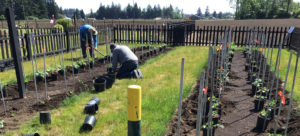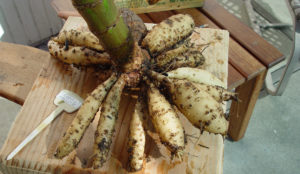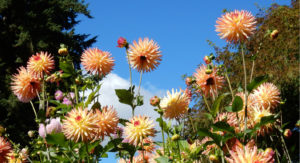
Everybody loves dahlias
Dahlias are easy plants to grow and yield beautiful blooms from mid-summer through fall. In many respects, “dahlia culture” is similar to “tomato culture.” If you can grow tomatoes in your garden, you can successfully grow dahlias. The following notes will help you to add spectacular blooms and brilliant color to your garden!
Choosing your plants
There is a huge range of colors and forms of dahlias. You will find many examples on this website. You can make your choice from the pictures you see here or from the pictures on the bags or from a dahlia friend’s recommendations. Just pick a couple and get started! You will enjoy spectacular color, variety and abundance of blooms from mid-July through the end of the growing season.
Getting your plants

Dahlia Society of Ohio getting ready for their plant sale – Photo by Robert Leonelli
There are several ways to get your first plants. Most major garden centers now sell dahlia tubers; that can be a very convenient way to get started.
Virtually every dahlia society has tuber and plant sales; they also welcome guests to those events. There are a number of advantages to this approach if there is a club near to you (see list on this site). Perhaps of greatest benefit of that source of tubers or plants is the availability of expert advice on your choices! That expert advice can continue through the season; a regular feature of many of our local society meeting is a Q&A session! The tubers at a society auction will also likely be locally grown and of good quality.
Of course, there are also small businesses that specialize in selling dahlias and dahlia materials by mail order or internet (see supplier list on this site). These suppliers are real experts on dahlias and their products are reliable and of good quality.
When to plant
Your tubers can go directly into the ground in the spring when the ground has warmed and there is little chance of frost. One good guideline is to plant in the same time frame as you would a tomato. If you want blooms as early as possible, you can start the tubers indoors in good light about a month before planting time. You will then have a small plant ready at planting time. Dahlias can be planted as late as mid-June in most parts of the country.
Where to plant

Planting at Canby Trial Garden – Photo by Larry Smith
Dahlias require a site with good drainage and partial to full sun. Pots are also increasingly popular way to grow dahlias. See other articles on this site for more information on growing dahlias in pots.
How to plant
Most dahlias need to be staked and you may want to plant a sturdy stake before you plant the dahlia. If you put the stake into the ground after the plant is growing, take care to avoid damaging the tuber or the root system. Tomato cages can also be a simple approach to staking.
Put the tuber in a hole several inches deep with the “eye” (like a potato sprout) on the tuber facing up. The eye is the point on the shoulder, or crown, of the tuber from which the plant grows.
If you are planting a number of dahlias in the same location, they should be separated by about 2 feet to give each plant room to grow.
Protecting your plants from pests
Small dahlia plants are susceptible to slug damage. It is a good idea to manually remove slugs early each morning or to protect them with a commercial slug killer.
Japanese beetles seem to enjoy eating dahlia blooms just when they are ready for a bouquet. One of the best methods of control is to manually remove the beetles into a bucket of soapy water.
Other insects can become a problem if you would like your blooms to be “perfect!” If that is the case, you might want to consider using an insecticidal soap or a commercial pesticide. Follow label directions carefully if you choose to do that.
Organic Approach
Dahlias take well to an organic approach to gardening. They are strong, robust growers with lots of blooms, including very large blooms. They do well in soil with lots of organic content even in the absence of chemical fertilizers. Pest control is not essential and can be reasonably well accomplished without resorting to chemical pesticides.
Deer resistance
Our suburban shrubbery and gardens are increasingly susceptible to damage by deer. The good news for dahlias is that they are low on the deer’s list of favorite foods. While dahlias are not “deer proof,” they are considered to be so in some parts of the country – probably those areas where deer find enough other plants they prefer to eat!
Watering and fertilizing
Young dahlia plants do not need a lot of water; in fact, excessive water can lead to rotting of the plant. For larger plants, a good rule of thumb is to water if the rainfall is less than one inch in seven days. Pots require more regular watering.
The best strategy for fertilizing is to begin with a soil test to determine pH and the specific soil needs. Lacking that information, the plants will generally benefit from regular treatments with a water soluble or granular fertilizer. Traditional wisdom for dahlias is to treat with a high nitrogen fertilizer through the middle of the season but minimize nitrogen at the end of the season.
Maintaining your plants
There is a substantial regimen that can be used for maintaining plants for show blooms. For the simple enjoyment of spectacular dahlias in your garden, there are two relatively simple actions that will enhance the appearance of the plant. First is tying the plant to the stake several times as it grows. The first tie should secure the lower portion of the plant’s stalk to the stake. Subsequent ties should secure the branches. A simple alternative to tying is to use a tomato cage to support the plant. Then, no tying may be required.
Second is disbudding. Remove the outer two buds from the three that develop at the end of each branch. While that reduces the total number of flowers, many flowers remain and those show up well on the plant. If all three buds are left on the stem, the blooms will tend to be covered up and can be lost in the plant. You can also remove some of the shoots that form along the branch to have stems that can be used in tall vases for elegant bouquets.
End of the season

Your dahlias will continue to bloom prolifically right up until frost. A heavy frost will kill the plant and leave you with a decision on your next step. You can do nothing with the plant. You will then need to plan on a visit to the local auction in the spring for the following year’s plants. Or, you can dig and discover that the plant has produced a half a dozen or more tubers like the one with which you started. If you wish, those tubers can be stored and grown by you and a couple friends next spring! Go to Dahlia University for information on harvesting and storing your tubers and for other topics mentioned on this page.

